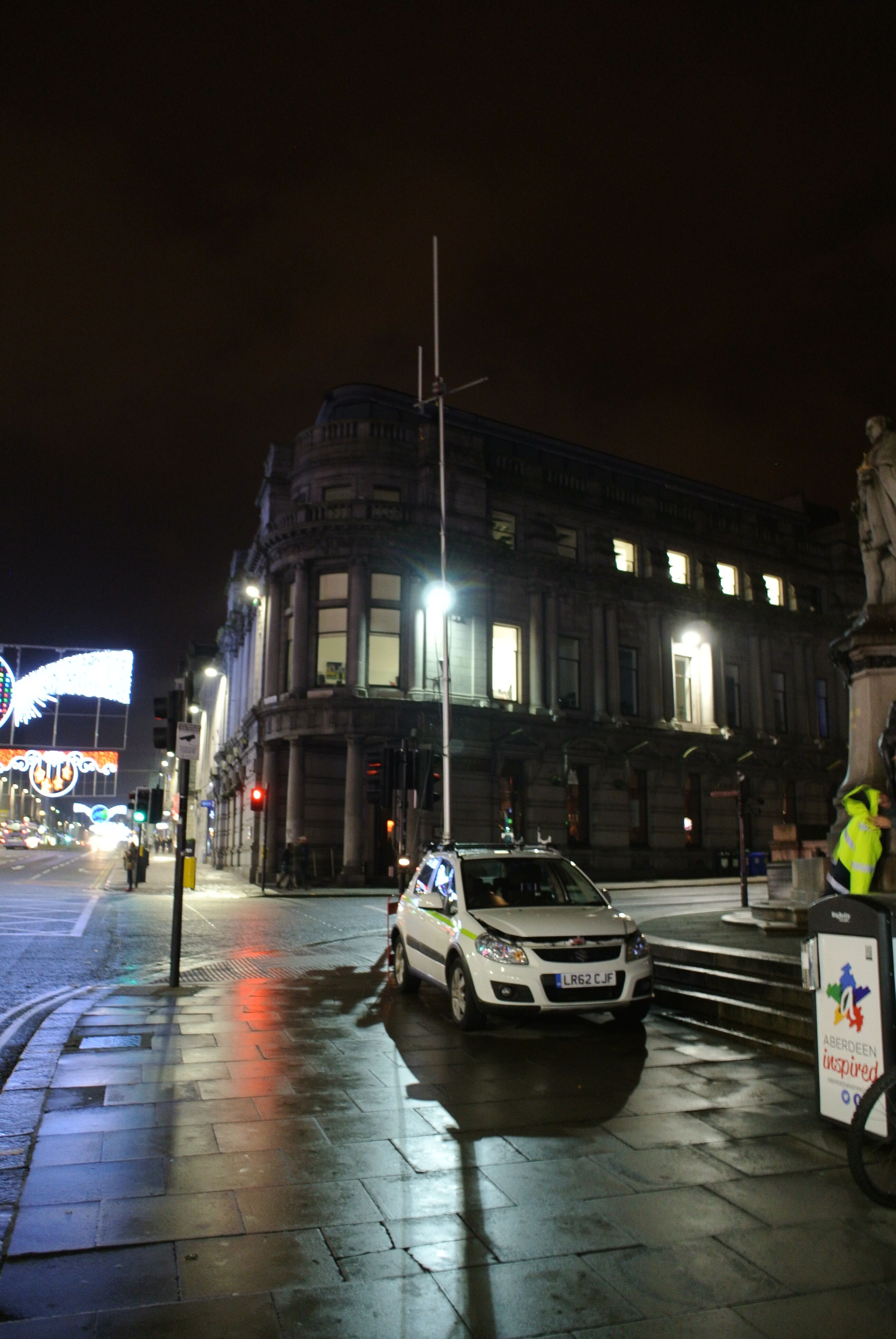Walking home from the hackerspace last night I came across this interesting
mast behind a car parked on the pavement. I had to grab a picture of this
strange thing on Union Street.

The guy operating the mast spotted me taking the picture and came down for a
chat. This mast was acting as a 4G base station, there was a second vehicle
driving around the city, listening for this mast to map 4G propagation. It
turns out that Aberdeen city council are planning to roll out 4G across the
entire city, with free access. The council want to use this for fleet
management and I think it is probably part of their initiative to improve
bandwidth in the city.
According to the operator of this mast the 4G won't just cover the city
center, they have been mapping industrial estates in Altens and out towards the
edges of the Bridge of Don
This weekend I got FreeBSD on my Chromebook Snow in a usable state. Getting
wifi going was a bit of a bother. I have an
Edimax Wifi Adapter
, but the
default kernel config builds out support for wifi and the urtwn device driver.
The Beaglebone Black page on the
FreeBSD wiki
has a kernel config that
includes the drivers I need. I took the wifi config and added them to a
CHROMEBOOK-WIFI config so I could build a kernel for the Chromebook with
support.
#USB WiFi
# Wireless NIC cards
device wlan # 802.11 support
options IEEE80211_DEBUG
device wlan_wep # 802.11 WEP support
device wlan_ccmp # 802.11 CCMP support
device wlan_tkip # 802.11 TKIP support
device wlan_xauth
device firmware # Required to load firmware
device urtwnfw # Firmware for RTL driver below
device urtwn # Realtek RTL8188CU/RTL8192CU
After building the new kernel and moving it over to the USB stick I use for the
Chromebook I needed tell FreeBSD to accept the license terms for the wifi
firmware.
Add to loader.conf
legal.realtek.license_ack=1
After that it was pretty norm wifi setup.
# ifconfig wlan0 create wlandev urtwn0
# wpa_supplicant -i wlan0 -c /etc/wpa_supplicant.conf -B
# dhclient wlan0
I found it quite difficult to get
GPGME
working with
Mutt
in OS X, I
was using
Homebrew
to install mutt. I could see the option in the brew
build file to use GPGME, but it was set as an optional dependency. I fought
with it for a while then jumped across to #homebrew on freenode to get an
answer.
I had to force brew to build mutt from source to get the dependency included.
You will have to uninstall mutt if you have already installed it.
brew install mutt --build-from-source --with-gpgme
You will need to add the correct bits to your .muttrc to get mutt to use.
set crypt_use_gpgme = yes
set crypt_autosign = yes
set pgp_sign_as = 0xYOURGPGKEYGOESHERE*****
I found a tool called
pv
via a Hacker News thread. pv or pipe viewer
allows you to view data as it is pulled out of a Unix pipe. This is really
helpful when dealing with long running commands. I used it today to check on
the progress of encrypting a large tar archive.
$ pv archive.tar.xz | gpg --sign --symmetric - > archive.tar.xz.gpg
6.51GiB 0:08:52 [6.23MiB/s] [======================> ] 70% ETA 0:03:47
While pv is running you get a progress, time elapsed, speed, a progress bar,
70% complete and an estimation of time until complete.
One of the facilities at
campGND
is going to be a wireless network. The
hope is to have the network running for the majority of the time. I have built
a wireless network at a campsite before, that was made easier by having
guaranteed bandwidth from a satellite terminal.
The plan is to have a wireless network for the campsite served by a
MikroTik
. Using a wireless bridge to reach to the farmhouse. The
farmhouse is out of site of the fields we are planning to use. Instead of
having wifi doing the full jump I am going to run ethernet as far as possible.
At
campGND
we are depending on a few things that could be fickle.
-
BT Home Broadband
-
A long run of ethernet
-
Solar Cells and a battery for network power.
Our final back haul is the BT network the site is pretty off the grid for phone
reception so we are stuck with BT. We have to be able to make a long hop form
the farmhouse before we can do a wireless link down to the site. The solar
cells will provide enough to run wireless access points during the day. I think
at night we might be a little drunk to care.
I still need to do some testing of the wireless hardware but the plan is to use
the following.
-
100M run of Ethernet.
-
Injected POE, then split POE.
-
2x WRT54G's.
-
A
MikroTik
access point.
-
Solar Cells for with battery backing for night time.
